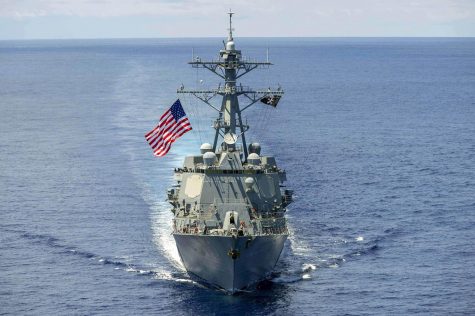OP-ED: Looking Toward a More Comprehensive Foreign Policy in the South China Sea

May 5, 2021
Last week, China dispatched 25 warplanes from the People’s Liberation Army (PLA) to fly over Taiwan’s air defense identification zone, escalating its already tense relationship with the United States. On NBC’s Meet the Press, Secretary of State Anthony Blinken responded to the situation by saying, “We have a serious commitment to Taiwan being able to defend itself. We have a serious commitment to peace and security in the Western Pacific. And in that context, it would be a serious mistake for anyone to try to change that status quo by force.”
The events of last week are the manifestations of China’s larger strategy of solidifying its regional and global influence, a strategy that has been in progress for at least a decade. As the world’s second-largest economy, largest exporter, and second-largest global military spender, China has positioned itself as the main rival of the United States and stands to hold the majority share of the global balance of power in the coming decades.
The expansion of China’s sphere of influence lies centrally in both establishing and maintaining China’s superpower status. If the twenty-first century is to be a Chinese one, China must guarantee its regional dominance. The vision behind this goal perhaps cannot be observed any better than in the South China Sea (SCS), where China has blatantly disregarded international maritime law and progressed down the road of militarization in order to establish its hegemony beyond its physical borders.
Following the Second World War and Japan’s loss of control of the SCS, Beijing laid claim to the body through an arbitrarily defined demarcation known as the “nine-dashed line” which encompasses the majority of the SCS. Despite intense objection from China’s neighbors in the SCS, namely Malaysia, the Philippines, Brunei, and Vietnam, China has proceeded with a standard narrative of singular sovereignty over the body. Moreover, China has continually shown its willingness to press its alleged claims through a “might makes right” strategy which has led to a naval buildup and the construction of military bases on the numerous islands, shoals, and reefs in the SCS.
The international community has weighed in on the issue and expressed that China’s claims do not align with the realities of international law. The 1982 United Nations Convention on the Law of the Sea (UNCLOS) guarantees a state’s sovereign right to exploit and conserve any resources extending two hundred nautical miles off its coastline; this region is called the Exclusive Economic Zone (EEZ). With the exception of China, all of the regional players stake their claim to territory in the SCS under this international agreement. This comes with the full knowledge that China is a state party to UNCLOS.
In 2016, the Permanent Court of Arbitration at the Hague ruled in favor of the Philippines, stating that China had trespassed into the Philippines’ territory and that there was “no legal basis” for China’s claim to resources falling within their “nine-dashed line.” Typically the Permanent Court of Arbitration presents the best method to achieving fair, internationally recognized mediations into matters of sovereignty and international disputes. China, however, dismissed the ruling and proceeded with its unlawful actions.
Practically speaking, the SCS is one of the most economically lucrative bodies of water in the world. Immediate and unimpeded access to billions of tons of untapped hydrocarbon reserves and the opportunity to fully exploit one of the world’s richest fisheries, which already accounts for a substantial slice of China’s annual catch of marine life and food security, has motivated China to disregard international law and norms to achieve their goals. For Beijing, disavowing obligations to international law in order to have non-rivalrous access to the SCS is patently a good tradeoff. Additionally, trade is a critical motivator behind China’s actions. “Over 64 percent” of its commerce traversed the SCS in 2016 and eighty percent of its oil imports pass through the Malacca Strait. Ensuring that it can continue to participate in trade and meet its energy demands is critical to China’s economic and national security. Establishing prior hegemony over the SCS offers China a reliable method to control commerce.
The SCS, moreover, is critical in China’s long-term strategic goals. In 2013, Chinese President Xi Jinping unveiled the “Belt and Road Initiative” (BRI), which calls for a twenty-first-century Maritime Silk Road, connecting China with Europe through the SCS and the Indian Ocean. The aforementioned initiative is a massive international infrastructure and investment project, designed to prop up economic growth while simultaneously legitimizing China’s authoritarian administration on the world stage. This plan, which would unquestionably increase China’s economic and political influence globally, cannot be actualized without guarantees of unencumbered Chinese dominance in the SCS.
From a security standpoint, having control of the SCS is instrumental in China’s success in the event of a future conflict. It would be in China’s best interest to have prior naval hegemony over the SCS, as a forced detour around the Malacca, Sunda, and Lombok Straits would mean vessels having to reroute around Australia to reach mainland China, a costly and dangerous proposition in the event of war. In essence, the prospect of a long-term closure of the SCS, which would adversely affect their supply chains for goods and hydrocarbons, motivates Beijing’s interest in controlling it. Moreover, allowing the SCS to remain open could allow rival navies, namely the United States, to more readily intervene on behalf of a foreign adversary, such as Taiwan.

For these reasons, China has decided that it is in its best interest to act with blatant disregard toward international norms in the SCS. The underlying motivations of profit and security, and the grand strategy of the Belt and Road Initiative simply outweigh China’s cooperation with its neighbors. A superior economy, military, a larger population, and the sheer momentum of China’s rise on the global stage leave her neighbors seeing their options dwindle with each passing year. While countries like Vietnam and the Philippines would certainly like to see that their EEZs are respected, this seems to be a passing hope rather than a tangible goal. Consequently, China’s neighbors may find it in their best interest to acquiesce to China’s power projection, allowing themselves to become party to the Belt and Road Initiative and relinquish their sovereign maritime rights in the face of a much stronger adversary.
Such a reality would be detrimental to the United States. Chinese control of the SCS threatens America’s ability to intervene in a potential military conflict between Taiwan and China as Beijing would be able to easily enforce a naval blockade around Taiwan. Furthermore, this compromises the United States’ ability to fulfill its defense obligations to the Philippines, South Korea, and Japan. Chinese control in the SCS could allow Beijing to restrict trade with America and its allies by limiting the freedom of navigation, which would be a distasteful economic reality. Simply put, Chinese hegemony over the SCS entails a shift in the global balance of power that America simply cannot commit to. If America expects to maintain its premier global status, the demonstration of competence, coherence, and thoughtfulness in the Indo-Pacific region is obligatory.
Briefly under the Obama administration and throughout the Trump administration, America’s strategy in the SCS has been to project military might through the use of Freedom of Navigation Operations (FONOPS). Essentially, this is when America sails a navy fleet through the SCS in order to project its military might to China and underscore its commitment to the free seas. Practically speaking, however, this has done little to stymie China’s accession or the manifestation of their own naval presence in the SCS. In fact, the very suggestion of American influence only encourages China to double down on its efforts and continue to militarize the region. Resultantly, these FONOPS amount to acts of brinkmanship, edging the United States and China closer to a conflict. Error on either side has the potential to embroil both countries in a costly war.
Commercial, diplomatic, and military partnerships between the United States and the other claimants in the SCS ostensibly furnishes the surest route in achieving America’s stated goals in the region. Through the strengthening of commercial and military ties, America stands to cultivate a more unified front against China’s encroachment in the SCS and keep the body free to navigate. Partnership building, moreover, provides much needed options for other claimants in the SCS who are facing incentives to acquiesce to China in order to become party to the lucrative Belt and Road Initiative. In the past, such a partnership has come to be through the Trans-Pacific Partnership (TPP) which garnered the support of key regional players like Malaysia, Brunei, Singapore, and Vietnam.
The TPP would have increased America’s geopolitical influence in the SCS region by fostering strong economic partnerships with China’s regional rivals. The TPP would have also offered a viable alternative to China’s BRI. Without a western option to achieve economic growth and prosperity, acceding to an illiberal, authoritarian-led initiative is becoming irresistible. By forging multilateral economic partnerships with China’s neighbors, regional players like Vietnam, and Malaysia would have been less reliant on Chinese trade and therefore more willing to press the legality of their claims in the SCS with less fear of economic repercussions. This attempt to bring neighbors into the American fold by writing the new rules of trade in the Asian Pacific was an attempt to force China to liberalize its trade methods in order to compete with the United States. As a result, this was intended to have a trickle-down effect where China would be compelled to reexamine its political dealings, potentially in the SCS, as a means to win over its neighbors.
Between the Obama and Trump administrations, however, inconsistencies arose in America’s strategy in the West Pacific. Days into his presidency, Trump pulled out of the TPP, severing any potential for collaboration with claimants and demonstrating an unattractive inconsistency in American’s foreign policy. Part of the reason China has been able to ascend so rapidly among other states is that its long-term foreign policy is consistent over years and even decades. America’s waffling only exhibits us as unpredictable, unreliable, and untrustworthy. Resultantly, such inconsistencies only weaken our goals in the region and encourage China’s neighbors to acquiesce to its aggression.
China’s neighbors in the SCS have interests that are explicitly aligned with our own, but time is running out. As China continues to ascend at the international level, these countries who are currently opposed to China’s practices in the SCS may decide that acquiescing to their pressure is the most viable strategy. America thus must offer an option like the TPP or a collective security agreement that provides claimants in the SCS with the tangible resolve and wherewithal to oppose Chinese aggression. While conflict must be avoided at all cost, without the presence of some notion of collective security, China’s neighbors stand to be steamrolled in the SCS. Commercial agreements, furthermore, put America in the driver’s seat in controlling the architecture of trade in the West Pacific and provides an option beyond the Belt and Road Initiative for claimants in the SCS. In the face of a unified opposition that is linked commercially and military, China may be forced to reexamine its own practices in the region and ultimately decide that abiding by international law is the best course of action.
America is at an inflection point in its history. Our position in the world is being questioned in the most direct way since the fall of the Berlin wall. The stakes, moreover, have never been higher. Countries around the world have been backsliding democratically since the start of the new millennium, and autocratic, Chinese-style rule, is increasingly being seen as a more stable and more lucrative form of government. If there was ever a time for America to reassert its ability to successfully navigate complex geopolitical problems, ensure the sanctity of international law, and keep the promise of democracy alive across the globe, the time is now. Proving ourselves as leaders in the SCS by assembling a coalition of aggrieved nations such as Vietnam, Malaysia, the Philippines, Singapore, and Brunei presents an occasion for the United States to redemonstrate its competence on the international stage.
Image Credit: “USS Kidd (DDG 100) is underway in the South China Sea.” by Official U.S. Navy Page is licensed under government works public domain; “South China Sea claims map” by Voice of America is licensed under government works public domain.







